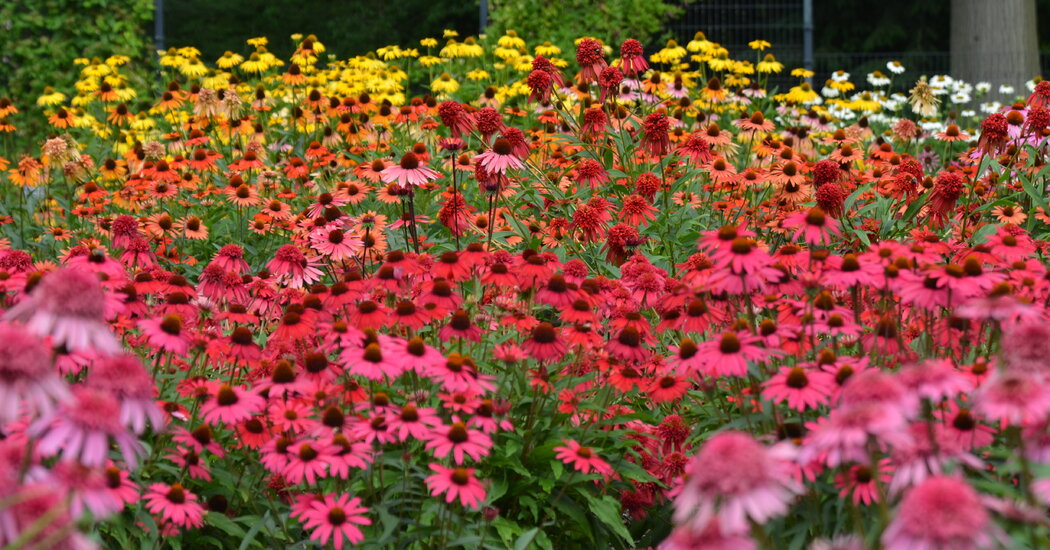Even to somebody intimately acquainted with the genus Echinacea, lots of the newest coneflowers elicit a double take. Some are practically unrecognizable; others signify a dramatic divergence from people who nature made.
It’s the wild ones that Kelly Kindscher, an ethnobotanist and professor of environmental research on the College of Kansas, has made the central theme of a profession centered on prairie plant communities.
“It’s actually an iconic American genus,” Dr. Kindscher stated of Echinacea, which many taxonomists rely as together with seven naturally occurring species, though some acknowledge as many as 10. Just one, Echinacea angustifolia — the westernmost species that he calls “an important medicinal plant of the prairie,” used for a whole lot of years by Native People — is discovered exterior the continental United States, in a small a part of the Canadian plains.
A few of the most up-to-date cultivars are decorative, Dr. Kindscher agrees, with their surprising sundown colours or fluffy double flowers. He will get it: He could also be a senior scientist with the Kansas Organic Survey, however he’s additionally a eager gardener himself.
However it’s important to surprise what the pollinators that developed alongside unadulterated native coneflowers — “robust prairie vegetation tailored for all times amongst grasses,” as Dr. Kindscher described them — consider these startlingly completely different variations.
What do bugs make of the coneflowers whose distinguished cones of tiny, fertile disc florets — a straightforward touchdown pad for his or her pollen-collecting visits — have been all however obscured by what appear like pom-poms? In these double flowers, derived from an opportunity mutation first noticed in a cut-flower subject within the Netherlands in 1997, the reproductive construction has been changed by one thing resembling a petal. And so the ecological providers the flower can provide are diminished, with much less pollen, much less nectar and normally fewer seeds.
The cone that types the middle of every flower, and is the prefix of the vegetation’ frequent title, was there for one more purpose, too, Dr. Kindscher stated. The spiny construction was meant to discourage predators’ grazing. (The Latin title Echinacea, which derives from the identical Greek phrase as hedgehog and sea urchin, hints at that perform.)
Even the acquainted Echinacea that you just see rising in nursery pots — the essential E. purpurea, or purple coneflower — isn’t fairly itself anymore. It has undergone subtler adjustments than these dramatic double flowers, however the store-bought purpurea has broader petals than nature’s model, a development that started within the Nineteen Sixties when a German breeder started making alternatives in favor of that trait. Within the wild type, what we regard because the petals (technically, the ray florets) are narrower and longer.
So earlier than you store, you have got a call to make: Are you planting a pollinator backyard or do you simply need some high-summer bloom for visible consumption?
Mt. Cuba Center, the native-plant backyard and analysis facility in Delaware, has some recommendation earlier than you go all doubles-crazy, which a current report from the group described as “a trade-off for model over substance.” Select properly, and you’ll have each.
Echinacea Put to the Take a look at
Mt. Cuba accomplished a second multiyear study of Echinacea in 2020, evaluating the numerous species and cultivars — a complete of 75 coneflowers, stated Sam Hoadley, the trial backyard supervisor who led the analysis.
From 2007 to 2009, the middle had studied 48 sorts of coneflowers. However with their rising recognition and the profusion of latest cultivars — typically known as nativars, for cultivars of native vegetation — it appeared time to revisit them, he stated. And the newest trial was designed to incorporate a function that had not been on the radar the primary time: a pollinator survey, or a tally of insect visitation carried out by a workforce of citizen scientists, with particular consideration paid to the distinction between single and double flowers, and their enchantment to bees, wasps and butterflies.
A few of the new Echinacea varieties are alternatives — that means {that a} inhabitants of seedlings was noticed and one of the best of the lot introduced ahead. Others are hybrids ensuing from one species being deliberately crossed with one other. That’s one thing that Echinacea vegetation are additionally comfortable to do by themselves, apparently.
“I feel if we had grown out all of the seedlings we weeded out from our trials we might have had fairly the kaleidoscope of vegetation,” Mr. Hoadley stated.
“It’s a promiscuous species,” Dr. Kindscher stated, “and we even see hybrids within the wild.”
Up to now, he has not seen hybridization between cultivars and wild vegetation, however the concern has been raised, and researchers are looking out.
An perception for gardeners who see an unusual-looking plant emerge in or close to a spot the place one was rising earlier than: “When individuals say, ‘My Echinacea has reverted,’” Mr. Hoadley stated, “what has occurred is that seedlings have germinated beside a mother or father. It’s not a reversion.”
One species, particularly, has proved irresistible to breeders, inviting the event of novel-colored coneflowers, starting within the Nineties: The canary-yellow Echinacea paradoxa, with a local vary centered within the Ozarks.
The epithet “paradoxa” is telltale, as this coneflower is a paradox in a genus whose palette is often restricted to purples and pinks. With yellow added to the gene pool, crimson and orange coneflowers turned doable.
And the Winner Is …
Not all coneflowers are as straightforward to develop or as adaptable as E. purpurea, a plant native to open woodlands all through the Jap United States. Its leaves are broader than these of different species, which supplies away its habitat of origin, indicating that it has sufficient leaf floor to do the job of photosynthesis, even in decrease gentle situations.
So it’s no shock that alternatives and cultivars that had been a minimum of partially derived from E. purpurea usually did one of the best within the Mt. Cuba trials. Lots of this coneflower’s cousins are taprooted, designed for pushing down into dry, skinny soil for moisture and penetrating crevices in fractured rock. The taprooted E. angustifolia, as an illustration, “likes the Nice Plains local weather and tends to die out in Jap and English gardens,” Dr. Kindscher stated. However E. purpurea has fibrous roots which are extra forgiving, even when it’s transplanted.
“Most of the top-performing cultivars originated from purpurea,” Mr. Hoadley stated, “and a few of the finest are those created by alternatives — with out numerous human affect.”
Newer Isn’t All the time Higher
What struck Mr. Hoadley most of all: A few the celebrities of the 2007-2009 trial remained the best hits greater than a decade later.
The historically coloured Pica Bella, a compact selection with distinguished orange cones which are a magnet for pollinators, was “our absolute prime performer,” he stated. Within the quest to patent new traits and varieties, it appears, glorious older vegetation like this one typically get left behind.
“Ask your nursery for it,” Mr. Hoadley stated. “Hopefully, client demand will assist carry it again to wider provide.” (Specialty mail-order suppliers like Digging Dog Nursery and Broken Arrow Nursery provide it some seasons.)
The white-flowered Aromatic Angel, additionally a purpurea, averaged by far essentially the most butterfly visits of any plant within the trial, and was successful with bees and wasps, too. Butterflies usually quantity to possibly 5 % of a coneflower’s insect visits, however this one rated 14 %.
One other extremely rated white selection was Snow Cone, a compact plant with the species Echinacea tennesseensis in its parentage.
Among the many top-performing hot-colored cultivars had been the coral Santa Fe, Postman and the Intense Orange providing within the Kismet collection — way more vigorous than early introductions on this colour vary, which frequently proved short-lived.
Echinacea pallida would have appreciated a drier, much less wealthy soil than the trial backyard supplied, Mr. Hoadley acknowledged, however its dramatically lengthy, drooping petals attracted his consideration.
Dr. Kindscher, too, questioned why it isn’t extra broadly grown. “I don’t know what breeders are engaged on, however an orange or crimson nativar of pallida with lengthy, droopy petals appears like one,” he stated.
And unsurprisingly: No double-flowered type that was trialed rated even an honorable point out.
Highly effective Vegetation
It was the medicinal energy of Echinacea, discovered about from Native People, that bought European settlers within the plant. Every tribe had its personal phrase for coneflower, and the translations differed, too, Dr. Kindscher writes in his 2016 ebook, “Echinacea: Natural Drugs With a Wild Historical past.”
The translations ranged from “medication makes you numb” (Kiowa Apache) to “chilly medication” (Hidatsa) and “one thing used to knock one thing down” (Lakota).
The primary vegetation had been despatched again to England within the late seventeenth century. Progressively, coneflowers made their method into gardens each physic and decorative, marking the long-ago roots of their now fast-evolving historical past in fashionable horticulture.
The identical bioactive compounds that made the species E. angustifolia essentially the most broadly used medicinal plant of the Plains tribes, Dr. Kindscher stated, served as safety towards bugs. Just like the spiny cone, their chemistry is a protection towards predation.
And talking of that spiny cone: It’s not simply Dr. Kindscher, Mr. Hoadley and the pollinators who’re in favor of retaining it intact and hedgehog-like. American goldfinches, who love meal of coneflower seeds, resoundingly agree.
Margaret Roach is the creator of the web site and podcast A Way to Garden, and a ebook of the identical title.
For weekly e mail updates on residential actual property information, join right here. Observe us on Twitter: @nytrealestate.

